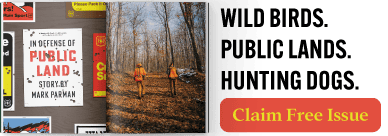Home » Grouse Species » Ruffed Grouse Hunting » Biological and Behavioral Adaptations That Help Ruffed Grouse Survive During the Winter
Biological and Behavioral Adaptations That Help Ruffed Grouse Survive During the Winter

Sage Marshall is a longtime outdoor journalist from southwest Colorado.…
Ruffed grouse have several adaptations, like pectinations and high feather densities, that help them survive during winter.
Not many species of birds take winter well. This is why birds like warblers, waterfowl, and American Woodcock migrate. Even the iconic wild turkey struggles to handle all the elements of the north country. Deep snow can prove to be a real hazard to turkeys.
But ruffed grouse are an exception. This non-migratory species thrives in challenging winter conditions. “Ruffed grouse are well-adapted to survive and even thrive in snowy and cold conditions when compared to nearly all other gamebirds found in North America,” explains Jim Woodford, the Forest Habitat Biologist for the Ruffed Grouse Society & American Woodcock Society (RGSAWS).
Hunters love the ruffed grouse, one of the most widespread native game birds in North America. The species’ range extends across woodland habitats from Canada’s northern province of Labrador all the way into Georgia and Alabama. The species is well-known for the way that males “drum,” or beat their wings against the air, during spring courtship rituals.
According to the RGSAWS, these birds typically weigh just 17 to 25 ounces. This is slightly heavier than a pigeon. The small size of these birds makes their ability to endure harsh winters even more impressive.
Thanks to biological and behavioral adaptations, ruffed grouse are able survive even in frigid and snowy conditions. Here’s how they’re able to do it.

Key Ruffed Grouse Winter Biological Adaptations
Ruffed grouse typically have a short lifespan. Approximately 55 percent of grouse don’t make it to their first breeding season. Predators like hawks and owls kill most young-of-the-year birds. Additionally, 10 percent of them don’t make it through the winter. However, the grouse that successfully survive do so because of specific biological adaptations.
For one, ruffed grouse grow “pectinations” on their feet each winter. “Pectinations are fringe-like skin projections that grow on the feet of ruffed grouse that increases their foot surface area,” explains Woodford. Sharp-tailed grouse are one of the only other upland birds in North America to grow pectinations during winter. “They essentially act as snowshoes for walking in soft snow and assist the birds in griping icy tree branches while feeding or roosting in winter.”
Additionally, ruffed grouse are known to develop increased feather densities during the cold weather months, giving them better insulation. The birds will also grow new bristles, particularly around their beaks. A recent study by Nicole Keefner, a researcher at the University of Maine, looked at whether this characteristic varies depending on the color phase of certain ruffed grouse, in part because grey ruffies are more prevalent than reddish ones in northern latitudes. However, Keefner’s study did not find a “meaningful difference” in feather densities between color phases.
“Grouse also fluff their feathers when it’s cold to increase the insulation surrounding their bodies,” adds Woodford. “This action decreases the amount of energy reserves a bird expends to survive a cold winter’s night.”
Winter Ruffed Grouse Behavior Changes
Ruffed grouse act differently during the coldest months, too. Chiefly, members of the species are known for using snow to their advantage—by burrowing in it. “Ruffed grouse will snow roost when snow is uncrusted and at least 8 inches deep,” says Woodford. “In a snow roost, the ambient air temperature can be up to 50 degrees warmer than the above snow temperature. Snow roosting saves grouse from having to metabolize high levels of their energy reserves and reduces the chance of being predated.”
Ruffed grouse also adjust their preferred habitat during the winter. In general, according to the Young Forest Initiative, ruffed grouse thrive in habitat with different-aged forests. These places provide a variety of food sources. Furthermore, the upland birds often thrive in mixed wood forests. But during the winter, the presence one type of tree can be especially important for their survival: conifers.
Conifer trees offer shelter beneath their boughs when there’s not enough snow to create snow burrows. Therefore, ruffed grouse typically utilize conifers in the southern end of their range, as well as in the north early and late in the season, and during low snow years. Mixed conifer forests also provide ruffed grouse access to key winter forage. This usually includes the buds and catkins of aspen, birch, cherry, ironwood, and hazel. Additionally, grouse tend to favor mature stands in the winter rather than young growth. Mature conifers allow for fast feeding and fast exits to a burrow for protection from predators.
Does Late Season Hunting Impact Grouse Survival?
Hunters are naturally interested in the impact of late season hunting on ruffed grouse populations. Unfortunately, the extent that such pressure has on ruffed grouse populations remains unclear.
One 2011 study published in the peer-reviewed journal Northeast Naturalist looked at the fall-winter survival of ruffed grouse in parts of New York. The Empire State is a historic stronghold for the species. However, has seen its ruffie population abundance decline significantly since the 1960s. The study’s authors sought to investigate concern from some wildlife managers that hunting, including late-season hunting, was significantly contributing to the species population decline. Instead, they found no evidence it was a limiting factor, or that decreased harvest limits would help. It’s not clear if these findings apply to ruffed grouse elsewhere.
Regardless, most scientists agree that the defining limiting factor for grouse populations always comes back to one thing: habitat. If there is healthy habitat, the chances of survival are greater than in areas that lack a healthy forest diversity. According to the Cornell Lab, the presence of young tree stands is key to ruffed grouse abundance, and therefore “grouse populations are higher in areas where logging, burning, and other disturbance create early-successional forests.”
With the right habitat, ruffed grouse can survive across much of North America, despite deep snow and cold temps, because of the species’ unique winter adaptations.
Sage Marshall is a longtime outdoor journalist from southwest Colorado. He has lived across the U.S. and currently resides in Western Montana, where he explores the rivers and mountains around Missoula with his partner, Bela, and their adopted bird dog, Gunney. He is a contributing writer and former editor for Field & Stream. His work has also been featured in nationally renowned publications such as Outdoor Life, Men's Journal, and Westword. He is the author of the poetry collection Echolocation (Middle Creek Publishing).




Grouse don’t grow feathers on their feet for winter, but flat fleshy projections called pectinations grow on the sides of their toes and act as “snowshoes”. Another advantage to snow roosting, which requires at least 10 inches of snow is that the grouse often dive into the snow while in flight, thus eliminating a scent trail for predators to follow. The late Gordan Gullion told me extending the grouse season into later winter would have little impact on the population. He said you’re never going to get them all. …I’m always in awe of ruff’s spectacular coloration, so beautiful and at the same time such perfect camouflage. They are the king!